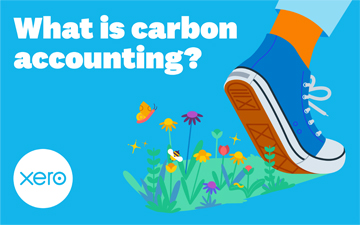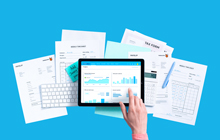So, what exactly is carbon accounting?

In recognition of World Environment Day on June 5th, Tamara Somers explains how accountants can help their clients with carbon accounting through Xero
 |
Tamara Somers is general manager of sustainability and ESG at Xero. |
CANADA is getting closer to setting carbon reporting standards for businesses. Earlier this year, the Canadian Sustainability Standards Board (CSSB) announced the launch of a public consultation to evaluate mandatory sustainability disclosure standards.
The global sustainability and climate-related financial disclosures from the International Sustainability Standards Board (ISSB) on which these regulations would be based may seem overwhelming at first, as they require complex and sometimes expensive methods to adhere to. However, the good news is that carbon reporting doesn’t have to be so complicated.
Carbon reporting regulations typically ask for businesses to report on CO2 emissions from across their entire supply chains, including suppliers. Naturally, this data can be difficult to track—especially for small business clients that may have limited resources. However, complying with mandatory emissions disclosures can be greatly simplified once you understand the principles of carbon accounting and emissions tracking and - leverage the appropriate tools.
Read on to learn more about what carbon emissions are, how to choose carbon accounting methodologies, the potential impact of adopting carbon accounting practices, and information on how to get started.
Defining and properly measuring greenhouse gases
Greenhouse gases (GHGs) are atmospheric gases that are responsible for causing global warming and climate change. And while many GHGs occur naturally, it’s important to note that human activities have undoubtedly led to an increase in the concentration of these gases, which has negatively impacted the life-sustaining qualities of our atmosphere. As such, monitoring GHGs is critical to better addressing and understanding the climate crisis.
Defining carbon accounting
By calculating emissions of greenhouse gases and expressing them as tonnes of carbon dioxide equivalent (tCO2e), carbon accounting encompasses the process of assessing an organization’s climate impact. It all comes down to a mathematical equation. Typically, emissions are calculated by multiplying an “emissions factor” (the average emissions generated by that activity in that location) by a set of business data (such as an office electricity bill, or employee travel expenses).
The end result of running through this process for a company’s entire operation is the output of the carbon accounting process: the business’s carbon footprint.
Understanding carbon footprints
Emissions within a business’s carbon footprint are typically reported on based on three scopes of business control and/or ownership:
- Scope 1: Direct emissions that are a result of company-owned or -controlled sources, such as a diesel generator, a fuel-powered forklift, or a company-owned gas car.
- Scope 2: Indirect emissions from a business’s purchase of generated electricity.
- Scope 3: Indirect emissions that are produced as a result of a business’s operations, such as corporate airline trips, using food delivery services, or even employees commuting by car to work.
To accurately calculate an organization’s total carbon footprint, emissions should be calculated not only as a function of core business services but also at each stage of the organization’s value chain. This means accounting for the emissions produced at every stage of the product or service lifecycle, from raw material development to transportation, transformation and distribution.
Carbon footprints have typically been calculated in large, complex spreadsheets that capture and summarize the total amount of GHGs that a business produces as a result of its total operations. A new and exciting development within the industry is the automation of measuring carbon footprints, using software solutions like Sumday and Greenly, which use advisor-friendly technology to streamline carbon accounting reporting. These tools draw data directly from accounting software platforms like Xero and give time back to you to focus on your clients by optimizing the process from start to finish.
Methodologies for carbon accounting
Global standards have been developed to ensure carbon accounting practices measure carbon emissions in a consistent and comparable manner. The most popular global framework for carbon accounting was created by the Greenhouse Gas (GHG) Protocol, whose standard provides guidance to organizations on the process for getting started on a carbon accounting journey as well as the correct methodology to use to ensure accurate and transparent reporting.
Why is this important to your client’s business?
Legislators, consumers, business operators and investors are progressively working to transition to a low-carbon global economy, with more and more countries opting for mandatory carbon accounting disclosure. Carbon accounting is an important step for businesses to understand and properly communicate their environmental impact with key external stakeholders. While carbon accounting disclosure is yet to become mandatory in Canada, the transition could impact Canadian businesses more quickly than you might expect.
Looking to the future, Canadian organizations may be required to provide carbon emissions data to satisfy the reporting requirements of their international partners, particularly in Europe, where large corporations will be required to disclose carbon emissions as early as this year. While reporting rules in most countries initially apply only to its largest organizations, the effects have the potential to trickle down to smaller organizations very quickly.
For example, in Australia, where the mandatory disclosure of climate-related financial information is currently being regulated by the federal government, small businesses won’t have to report themselves potentially until January 1, 2025—however, they will be impacted by these requirements in the immediate term. This is because small businesses are a critical part of larger businesses’ supply chains and their data will be required for larger organizations to achieve compliance. In Singapore, where emissions reporting has become mandatory for large businesses, 8 out of 10 businesses say they have lost business because they were unable to meet the requirement to provide emissions data to customers.
How to get started
Now is the time for Canadian organizations to get ahead of this process as carbon accounting is sure to make its way to Canada. By getting on top of this early, businesses can future-proof their positions in the broader green economy, providing a competitive edge compared to those who lag behind.
A low-barrier way to get started is by using a carbon accounting application, like the ones found in the Xero App Store. These apps provide a secure way to connect to your client’s Xero account, so you can analyze their business data to calculate their carbon footprint efficiently. Additionally, these apps offer guidance along the way for you and your clients through the Xero customer support team—ensuring a smooth way forward through the entire process.
Tamara Somers is general manager of sustainability and ESG at Xero. Advertising feature content and images produced by Xero.









(0) Comments